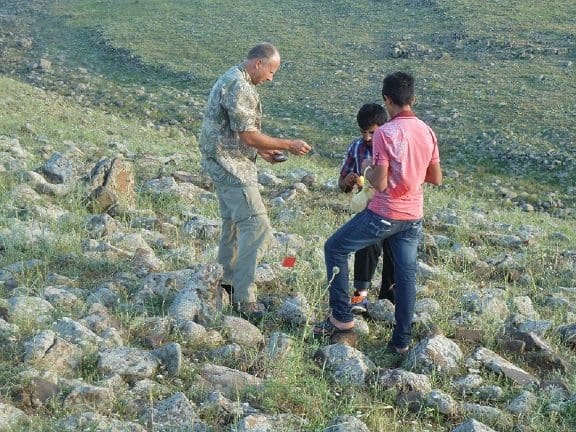A PIONEERING, multi-nation research collaboration is expected to unlock valuable new opportunities for chickpea production in Australia.
Researchers supported by the Grains Research and Development Corporation (GRDC) have collected and multiplied wild chickpea species from the Middle East to build a unique genetic resource from which important traits are being screened for potential incorporation into new disease-resistant, stress-tolerant, high-yielding varieties for Australian growers.

CSIRO’s Jens Berger tags wild chickpea plants during a collection mission to Turkey. (Photo: J Berger, CSIRO)
GRDC Pulses and Oilseeds manager, Dr Francis Ogbonnaya, says the “very exciting” research undertaking is likely to lead to a substantial expansion of Australia’s chickpea production area, especially in regions where opportunities to grow chickpeas have been limited due to the unavailability of lines tolerant to constraints such as acidic soils, abiotic stresses and disease stresses.
“Not only are chickpeas Australia’s most valuable cash crop, they also play an important role in terms of overall optimisation and sustainability of our farming systems,” Dr Ogbonnaya said.
“They act as a break crop for cereal rotations, they add nitrogen to the soil, assist with weed control and they add diversity to a grower’s marketing options.
“But, until now, the genetic base of the domesticated chickpeas we grow today has been very narrow and this has prevented many of our grain growers from being able to grow chickpeas and enjoy all the benefits these pulse crops bring.
“This research program will open up fantastic opportunities for development of new, resilient varieties for our growers to choose from. The potential impact is quite substantial.”
Dr Ogbonnaya cited the Western Australian situation as an example of that potential impact, stating that chickpea production in that state alone could possibly expand by 100,000 times current levels.
“In New South Wales and parts of Queensland, chickpeas are thriving, but in WA only 5000 hectares was planted to chickpeas last year. The primary reason for that is we don’t have chickpeas adapted to acidic soils,” she said.
“If growers had access to varieties with acid tolerance – and evidence is already showing those traits exist in the wild material we now have available – the area planted to chickpeas in the west could potentially be around 500,000ha. Growers would have a valuable break-crop alternative to lupins, and they would reap the benefits that growers in other regions experience.”
The international collaboration to expand the world’s chickpea genetic resources began with a GRDC-supported collection mission to Turkey (where the legume was first domesticated) in 2013 and has since developed into a $12 million five-year research program involving eight countries and numerous institutions and laboratories around the globe.
The collection mission, the success of which was contingent on Turkish collaboration, was supervised by CSIRO ecophysiologist Dr Jens Berger who has researched chickpea biodiversity and identified serious gaps in the gene pool.
The painstaking search for and collection of wild genetic material from south-east Turkey, some of which is now being housed at the Australian Grains Genebank in Horsham, Victoria, has led to the capture of an immense amount of valuable genetic and trait diversity.
“Early indications are good for the presence of traits such as water use efficiency, chilling tolerance and nematode resistance,” Dr Berger said.
“I am optimistic that we captured the adaptive diversity needed to improve the performance of cultivated varieties.”
The newly-expanded genetic resource base has been shared among the collaborating countries – Australia, the United States, Turkey, Ethiopia, India, Pakistan, Canada and Morocco – and is now underpinning a series of GRDC project investments that are seeking to introduce valuable new traits from the wild species into domesticated chickpeas suitable for production in Australia.
The wild genetic material is being screened for important traits such as tolerance to acidic soils, drought, heat and cold, as well as water use efficiency and resistance to diseases such as ascochyta blight (the most important disease of chickpeas in Australia), Phytophthora root rot and root lesion nematode.
With technology enabling researchers to produce four chickpea generations in one year and large-scale screening to begin next year, Dr Ogbonnaya is hopeful that new lines of chickpeas with traits from the wild accessions will be made commercially available to Australian growers in the “medium term”.
The delivery of such new commercial lines will be the culmination of an extensive and concerted international effort in which Australia has played an important role: “This program has demonstrated that there are some things that cannot be done on your own,” Dr Ogbonnaya said.
“Multi-lateral approaches to tackling major issues are the way forward – no one country can do it alone. To see eight countries coming together to drive innovation for the future is terrific.”
Dr Ogbonnaya said the likely expansion of Australian chickpea production could also promote opportunities in the area of functional nutrition.
“It’s certainly exciting times – for the research community, our plant breeders, our growers and the wider community.”
Source: GRDC
GRDC’s Australian research partners involved in the research include the CSIRO, the University of Southern Queensland’s Centre for Crop Health, the Centre for Crop and Disease Management in Western Australia, Murdoch University, the Centre for Plant Genetics and Breeding at the University of WA, New South Wales Department of Primary Industries, the University of Sydney, Curtin University and the South Australian Research and Development Institute (a division of Primary Industries and Regions SA).
Grain Central: Get our free daily cropping news straight to your inbox – Click here



HAVE YOUR SAY